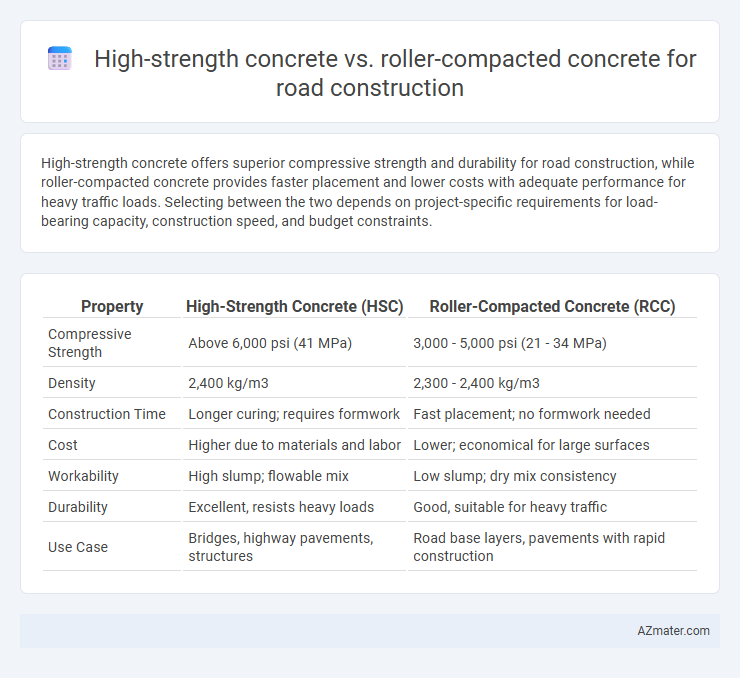High-strength concrete offers superior compressive strength and durability for road construction, while roller-compacted concrete provides faster placement and lower costs with adequate performance for heavy traffic loads. Selecting between the two depends on project-specific requirements for load-bearing capacity, construction speed, and budget constraints.
Table of Comparison
| Property | High-Strength Concrete (HSC) | Roller-Compacted Concrete (RCC) |
|---|---|---|
| Compressive Strength | Above 6,000 psi (41 MPa) | 3,000 - 5,000 psi (21 - 34 MPa) |
| Density | 2,400 kg/m3 | 2,300 - 2,400 kg/m3 |
| Construction Time | Longer curing; requires formwork | Fast placement; no formwork needed |
| Cost | Higher due to materials and labor | Lower; economical for large surfaces |
| Workability | High slump; flowable mix | Low slump; dry mix consistency |
| Durability | Excellent, resists heavy loads | Good, suitable for heavy traffic |
| Use Case | Bridges, highway pavements, structures | Road base layers, pavements with rapid construction |
Introduction to High-Strength Concrete and Roller-Compacted Concrete
High-strength concrete (HSC) offers compressive strengths typically exceeding 6,000 psi, providing enhanced durability and load-bearing capacity for demanding road construction projects. Roller-compacted concrete (RCC) is a zero-slump concrete mixture compacted by vibratory rollers, combining the strength of traditional concrete with rapid placement techniques ideal for large-scale pavement applications. Both HSC and RCC improve road performance, but their distinct material properties and construction methods cater to specific engineering and economic requirements.
Material Composition and Structural Properties
High-strength concrete for road construction typically contains a higher cement content, lower water-cement ratio, and admixtures like silica fume or superplasticizers to achieve compressive strengths exceeding 8,000 psi, enhancing durability and load-bearing capacity. Roller-compacted concrete combines conventional concrete ingredients with minimal water content, resulting in a drier mix that can be compacted using heavy rollers, offering high density and resistance to deformation under heavy traffic loads. The structural properties of high-strength concrete emphasize tensile strength and crack resistance, whereas roller-compacted concrete prioritizes rapid construction and cost-efficiency while maintaining sufficient compressive strength for highways and pavements.
Mixing and Placement Techniques
High-strength concrete for road construction requires precise mixing with low water-cement ratios and often includes superplasticizers to achieve dense, durable mixes suitable for high-load pavements. Roller-compacted concrete (RCC) utilizes a drier mix with zero-slump consistency, placed and compacted using vibratory rollers similar to asphalt paving, enabling rapid layering and large-scale applications. While high-strength concrete demands careful batch control and formwork to prevent segregation, RCC's placement emphasizes speed and compaction, reducing formwork needs and accelerating construction timelines.
Strength and Durability Comparison
High-strength concrete (HSC) offers superior compressive strength typically exceeding 6,000 psi, making it ideal for heavy-load roadways requiring exceptional durability against traffic stresses. Roller-compacted concrete (RCC), although generally exhibiting lower compressive strength around 4,000 to 5,000 psi, provides enhanced durability through a dense, low-slump mix that resists cracking and degradation under cyclic loading. The choice depends on specific project demands, where HSC excels in structural strength while RCC delivers cost-effective durability and rapid construction benefits for large-scale road surfaces.
Cost Efficiency and Resource Allocation
High-strength concrete offers superior durability and load-bearing capacity but demands higher material costs and longer curing times, impacting overall project budgets and timelines. Roller-compacted concrete (RCC) provides a cost-efficient alternative with faster placement and reduced cement content, optimizing resource allocation in large-scale road construction. Choosing between high-strength concrete and RCC depends on balancing long-term maintenance savings against initial expenditure and available workforce expertise.
Application Suitability for Road Construction
High-strength concrete offers superior load-bearing capacity and durability, making it ideal for heavy-traffic highways and bridges requiring long service life with minimal maintenance. Roller-compacted concrete provides rapid construction benefits and cost efficiency, especially suited for large-scale road bases and pavements where quick compaction and early strength gain are critical. Selection depends on project demands such as traffic volume, structural requirements, and construction speed.
Construction Speed and Project Timelines
High-strength concrete offers enhanced durability but requires longer curing times, which can slow construction speed and extend project timelines. Roller-compacted concrete (RCC) enables rapid placement and compaction using heavy machinery, significantly accelerating construction processes and reducing overall project duration. Choosing RCC for road construction optimizes timelines where fast-track completion is critical, while high-strength concrete is preferred for applications demanding superior load-bearing capacity despite longer curing periods.
Maintenance Requirements and Lifespan
High-strength concrete offers superior durability and longer lifespan, often exceeding 50 years with minimal maintenance due to its dense microstructure and high compressive strength. Roller-compacted concrete, while cost-effective and rapid to place, typically requires more frequent maintenance because of its relatively lower strength and susceptibility to surface wear and rutting. Choosing high-strength concrete reduces lifecycle maintenance costs, whereas roller-compacted concrete demands ongoing repairs to maintain road integrity over time.
Environmental Impact and Sustainability
High-strength concrete reduces material usage through enhanced durability and load-bearing capacity, lowering overall carbon emissions over a road's lifecycle. Roller-compacted concrete offers significant environmental benefits by requiring less cement and water, producing less waste, and enabling faster construction with reduced energy consumption. Choosing environmentally responsive road materials involves balancing high-strength concrete's longevity with roller-compacted concrete's resource efficiency and rapid application.
Summary: Choosing the Right Concrete for Road Projects
High-strength concrete offers superior compressive strength and durability, making it ideal for heavy traffic and long-term performance in road construction. Roller-compacted concrete provides rapid placement and cost-effective solutions with adequate strength for various pavement applications, especially in large-scale projects. Selecting the right concrete depends on project-specific factors such as load requirements, construction speed, budget constraints, and environmental conditions.

Infographic: High-strength concrete vs Roller-compacted concrete for Road construction
 azmater.com
azmater.com